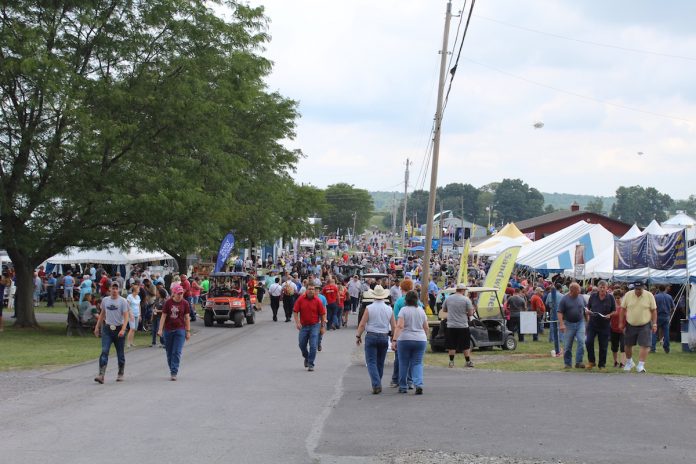For the first time, Pennsylvania State University’s Ag Progress Days were held entirely online this year.
The COVID-19 pandemic was a hot topic in webinars throughout the event.
At a town hall Aug. 10, Penn State College of Agricultural Sciences Dean Richard Roush and Pennsylvania Secretary of Agriculture Russell Redding spoke about the impact COVID-19 has had on the commonwealth’s agriculture industry.
The pandemic, Redding said, revealed some good things and some not-so-good things. Despite widespread disruptions in the food supply chain this spring, Redding believes Pennsylvania’s food supply is in a good place now.
“I think that’s a success story, given where it was 120 days ago,” Redding said.
Redding said there’s no guarantee interruptions will never happen again. But while things are more stable, he added, it’s important to talk about what can be learned from these challenges and how to strengthen the food supply chain.
Processing
Issues with workers becoming ill in processing facilities, as well as changes in schools’ and other institutions’ needs — as people shifted to remote work and education — caused challenges with processing and distribution.
Pennsylvania, like many states, has struggled with processing availability. Some local processors are booked for a year out.
Redding said the state has needed more processors for a while.
But there are different types of processors, with different inspection needs. Redding believes the state needs to assess how to best take advantage of the increased demand for local processing before it can really respond.
Roush said the university does promote local food distribution. For some stores, however, that’s difficult, especially in a place like Pennsylvania, where not everything grows year-round.
Redding believes large retail stores are seeing the weaknesses in their supply chains. He said his department has talked to a lot of retailers about local food sources recently.
“We’re in the arena because everybody now has got a concern about food access,” Redding said. “The key is making sure that workers are safe.”
Biosecurity
In an Aug. 10 webinar, Gregory Martin, of Penn State Extension, discussed how farms can improve biosecurity for workers and animals.
“The best thing we can do is to be prepared,” Martin said.
Biosecurity plans, he said, are important. If there isn’t a specific, usable plan in place, nobody is going to practice it. The three levels of defense for biosecurity are physical, chemical and logical barriers.
Physical barriers are things like masks and goggles. Chemical barriers are disinfectants and soaps. Logical barriers are practices to logically reduce contact with infectious agents — for example, visiting sick animals last so that you don’t spread disease to healthy animals.
Martin said workers need ways to wash their hands on and off the floors. There should be sanitizing stations. When necessary, workers should stagger lunches.
Martin recommended compartmentalizing the farm, with lines of separation between different areas. Any time someone crosses a line, they should take some type of action for biosecurity, whether it’s washing hands, cleaning and disinfecting boots or removing disposable PPE. Farms can also divide into smaller sections and keep workers in each section separate to reduce exposure.
Visitors should be limited to people who really need to be on the farm and kept track of in a log book or something similar, he said.
Critical
Despite the health challenges the virus brought, farms, processing plants and other agricultural businesses continued to run throughout the pandemic.
One of the priorities at the beginning of the pandemic, Redding said, was making sure agriculture was defined as a life-sustaining industry, and figuring out who was connected enough to agriculture to be included. For example, suppliers of packaging and pest control are important for agriculture.
“We learned a lot about who was out there,” Redding said. “We now have a much better idea of who’s in this business.”
Roush said considering agriculture a life-sustaining business helped the university handle its shutdown. Some research was too urgent to pause, and the designation allowed it to keep some labs open.
“We kept the spotted lanternfly research going,” Roush said. “It wasn’t going to wait for us.”
Grief
Many other things had to wait, though. In a presentation titled “Grief, Loss and COVID-19,” Karen Bracey, of Penn State Extension, said we have lost a lot to the pandemic — events, routines, time with family and friends. Though not everyone has directly lost loved ones to the virus, many are struggling with grief.
“Everybody in our life right now is going through losses,” Bracey said.
But there are ways to take care of yourself during grief, and to support others who are experiencing grief.
“Empathy is the key,” Bracey said. “It can be hard if we have a lot of people who we feel are requiring our empathy at this point … but it is really important to work to find that.”
Stages
Stages of grief are not linear, but the stages of grief look very similar to what many people have been experiencing. There’s denial. At the beginning of the pandemic, many people couldn’t wrap their heads around what was happening.
There’s anger. Many felt angry about events being canceled and things being closed.
“Anger is necessary because we lost something, and it’s not fair,” Bracey said.
There’s bargaining — some people hoped that if they just adjusted their routines for a couple of weeks, things would go back to normal.
There’s depression.
“This is when our minds have had the opportunity to process it,” Bracey said. “Now our emotions are able to kick in because we’ve been able to process the mental part of it.”
There’s acceptance. It doesn’t mean grief is over, Bracey said, but that we’ve accepted the reality and can start to work through it.
Finally, there’s finding meaning. Bracey said this can be summed up as post-traumatic growth. We can see how communities pulled together, or identify opportunities to improve.
“The process of finding meaning can be very healing … but it’s not something that can be forced,” Bracey said.












